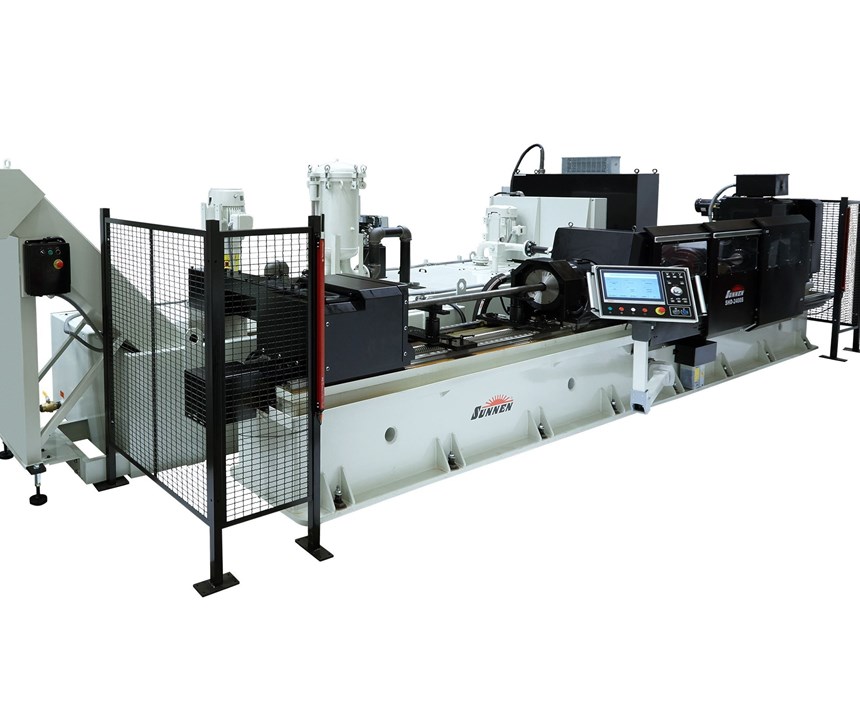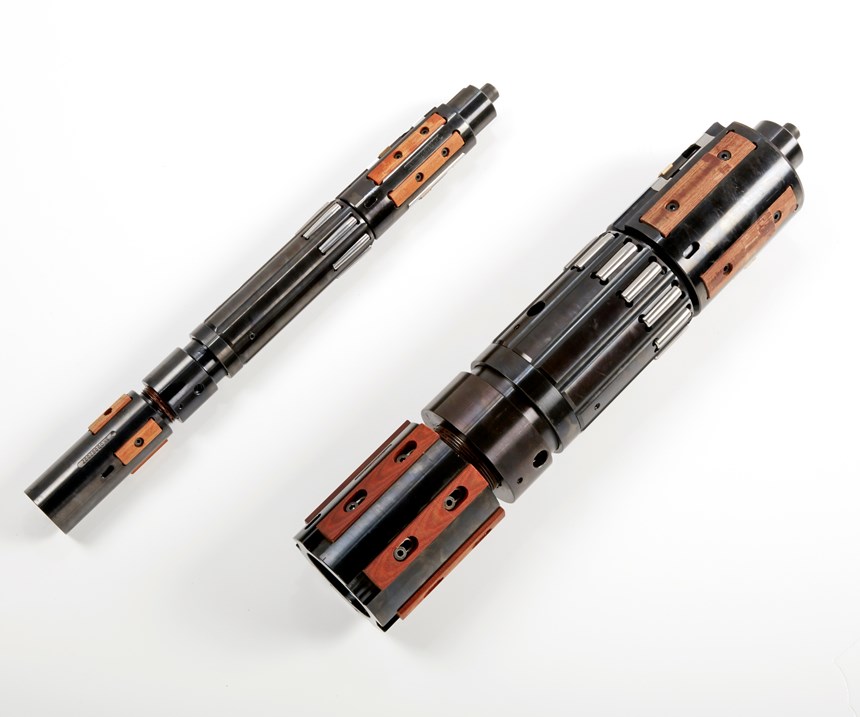Single-Pass Skiving and Roller Burnishing for Hydraulic Cylinders
A newly introduced machine and tool combination from Sunnen streamlines skiving and roller burnishing by combining operations into a single stroke process on a single tool.
A newly introduced machine and tool combination from Sunnen streamlines skiving and roller burnishing by combining both operations into a single-stroke process on a single tool. In operation, the leading skiving section of the tool acts as a rougher typically removing 0.030 inch of material or more depending on the application. It is followed by the roller burnishing tool, which finishes the bore surface to a 6-microinch finish or better. Combining these operations into a single pass results in a system that is 60 to 70 percent faster than traditional honing processes with comparable size tolerance and surface finish results.
The combination skiving and roller burnishing process is designed to successfully finish a variety of part types in various materials. It is especially suitable for high production hydraulic cylinder applications. The Sunnen machine is available in two models—the SHD 2400 for part lengths of up to 2 meters and the SHD 4400 for part lengths ranging up to 4 meters. The bore diameters range from 2 to 7 inches (51 to 178 mm), which represents about 70 percent of the high volume hydraulic cylinder market.
The addition of skiving and roller burnishing to Sunnen’s traditional honing product portfolio expands the company’s coverage of the precision bore finishing market. The combination skiving and roller burnishing tool comes from Sunnen’s acquisition of U.S. manufacturer of deep hole tooling and systems for primary hole generation, BTA Heller.
“By augmenting its honing solutions with skiving/roller burnishing capabilities, Sunnen is able to offer an objective consultation on the most cost-effective bore finishing process for each bore-sizing application,” says Phil Hanna, Sunnen product manager. “The skiving/roller burnishing addition makes the company a one-stop shop for machines, tools, coolant systems, cutting fluids and chip management, all designed to reduce costs and improve efficiency for bore-finishing operations.”
The SHD machine is powered by a 76-hp (57-kW) spindle motor that uses an inverter drive for optimum power. It tracks on 2.16-inch (55-mm) linear ways that provide smooth, non-stick slip feed for maximum control of the cutting head. Its ballscrews are 3.25 inches (80 mm) in diameter and use Beckhoff servodrive actuation for tool feeding and part clamping.
“Targeted at the heart of the hydraulic cylinder market, the SHD is designed for volume production of relatively standard cylinders. For more specialized cylinders requiring a cross-hatch pattern for oil retention, honing is the preferred process,” Mr. Hanna says. Candidates for the SHD skiving/roller burnishing system include the agriculture, heavy-duty construction, mining, motion control and material handling industries and others that produce hydraulic actuation cylinders within the machine’s capacity range.
Within its targeted manufacturing market, most producers use tube stock as the raw material. Generally not pre-processed, the tube is simply cut to length and mounted on the machine for processing the ID.
Skiving is able to accurately size bores despite variability in wall thickness. The skiving/roller burnishing toolhead uses a hydraulically actuated expanding mandrel mechanism that is preset to the desired diameter size. The toolhead floats on the tool drive shaft to self-center, and the drive shaft itself uses a vibration damping system to eliminate chatter marks.
On the SHD system, the skiving process is followed immediately by the roller burnishing process that uses the expanding mandrel mechanism as well. At the end of the stroke, the skiving tool extends through the bore so the burnishing tool can complete its stroke.
The Sunnen machine uses a unidirectional skiving/roller burnishing stroke. At the end of the cutting stroke, the skiving and burnishing tools retract and are withdrawn from the bore. The retraction is sufficient so that no contact is made on the walls of the finish bore, meaning there are no drag lines or scratches in the bore. The rigidity of the machine and cutting/finishing toolhead combination hit the size and finish tolerances without the need for a cleanup pass.
In the skiving/roller burnishing process, two traditionally separate operations are combined into one. A critical consideration to making this multitasking operation work is coolant and chip control.
Skiving is a metalcutting process and therefore generates chips. Depending of the variability of wall thickness of the sized tube stock being used, the amount of these often stringy chips can be significant.
With the roller burnishing process immediately following the skiving process, and performing its surface finish operation, the chips must be clear or there is a risk damaging the surface of the bore. In a two-step process, skiving followed by roller burnishing, this is less of an issue. However, to take advantage of the time savings of combining the two operations into a single stroke, chip control is critical.
The SHD uses a specific cutting oil or water-based coolant for this operation that works to flush the skiving chips toward the front of the machining stroke, ahead of the skiving tool, so the roller burnishing tool has a clear surface to work with. The cutting tool head is plumbed in such a way that the cutting oil forms a jacket around the tool that flushes the chips ahead of the operation and out the end of the bore into a chip removal and oil recovery unit.
Sunnen partnered with Prince Manufacturing on the development and testing of the SHD system in Prince’s Lewis and Clark Hydraulics facility in Yankton, South Dakota, ensuring it met all of the critical needs of the market, from overall machine layout to the details on the control screens. Prince is one of the industry’s premier manufacturers of hydraulic valves, pumps, cylinders and accessories, with five plants in the U.S.
In a beta test at the Prince facility, a 3-inch ID by 12-inch long tube is successfully skived and roller burnished in 10 to 15 seconds with spot-on specs. “That would take us 60 percent longer with honing,” Mr. Hanna says, “which is why shops are looking at the skiving/roller burnishing process as an alternative for the right application.”
It’s the ability to bring the various factors that comprise the system approach needed to perform a skiving/burnishing combination process that gives Sunnen a competitive edge. The company takes responsibility for the machine, tooling, workholding chip management and cutting fluid to provide a complete solution for production bore sizing and finishing operations of hydraulic cylinders.
Read Next
Skiving Long, Slender Parts with Tight Tolerances
Here's a look at one of the oldest and most efficient methods of screw machine production for parts that are long and slender, with close-diameter tolerances and finishes, or parts that require truly spherical radii.
Read MoreSeeing Automated Workpiece Measurement in Real Time
User-friendly inspection software for CNC machining centers was shown at IMTS 2024 monitoring measurements between and after machining while performing SPC based on recorded measurement values.
Read More5 Aspects of PMTS I Appreciate
The three-day edition of the 2025 Precision Machining Technology Show kicks off at the start of April. I’ll be there, and here are some reasons why.
Read More.png;maxWidth=970;quality=90)
















.png;maxWidth=300;quality=90)




